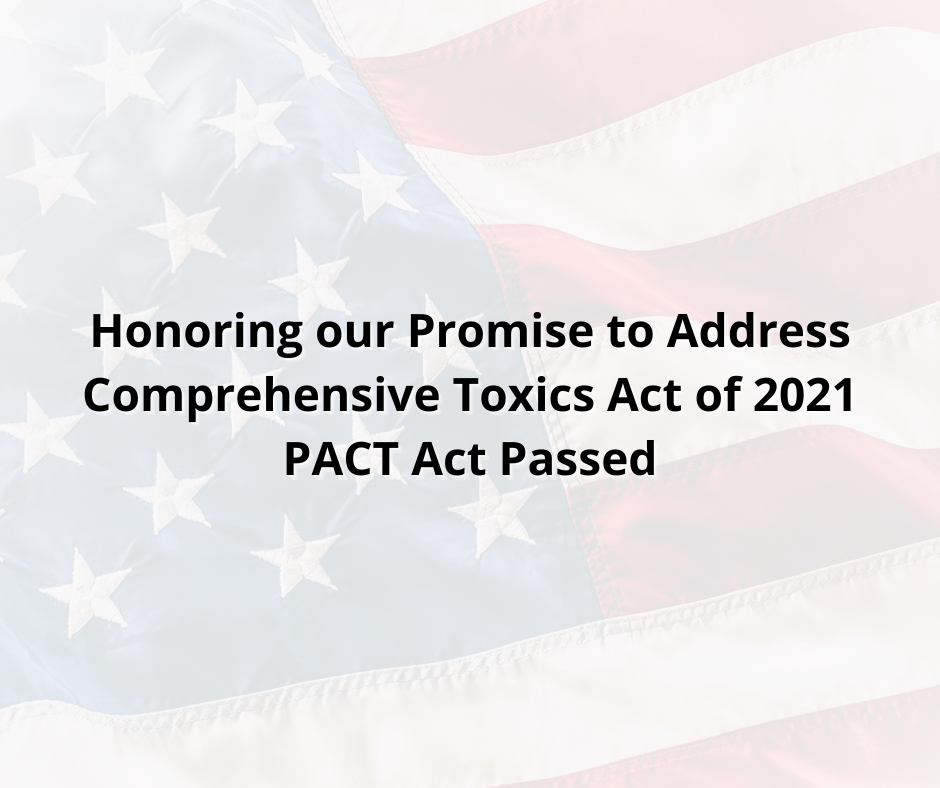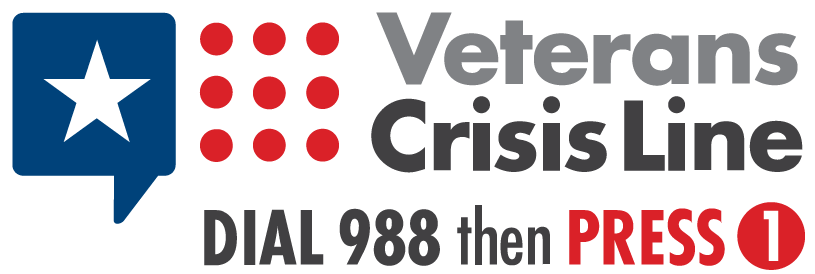
Honoring our Promise to Address Comprehensive Toxins Act of 2021.
What is the PACT Act?
The long-awaited PACT Act has passed in the House and the Senate and is on the way to the White House. The Act focuses on the presumptions of service connection for Veterans exposed to toxic substances during active military service.
The Nine Titles of the PACT Act
Bergmann and Moore is here to help you understand the elements going into the PACT Act and what these changes mean for Veterans. The following breakdown is from Congress.gov. and is only a summary of the many elements that make up the Act.
Title 1: Expansion of health care eligibility
Expansion of health care for specific categories of Veterans exposed to toxic substances and Veterans supporting certain overseas contingency operations.
- Operation Enduring Freedom
- Operation Freedom’s Sentinel
- Operation Iraqi Freedom
- Operation New Dawn
- Operation Inherent Resolve
- Resolute Support Mission
Subtitle B: Certain Veterans of Combat Service and other matters: Expansion of the period of eligibility for health care for certain Veterans of combat service. The period for health care eligibility has been adjusted to after September 11, 2001, and now includes a 10-year period. This applies to a Veteran that was discharged from active military, naval, air, or space service after September 11, 2001, and before October 1, 2013, but did not enroll to receive hospital care, medical services, or nursing home before October 1, 2022.
Title 2: Toxic Exposure Presumption Process
This title creates an outline for the Secretary of VA to follow when establishing or removing a presumption. There must be a public notice regarding what formal evaluations the Secretary plans to conduct and allow the public an opportunity to comment on the proposed formal evaluations.
This title also improves the ability of VA to establish presumptions of service connection based on toxic exposure.
Outreach to claimants for disability compensation since changes in presumptions of service connection has been adjusted. This means VA must identify all claims for compensation that were submitted to the Secretary, that were previously evaluated and denied by the Secretary before the date on which the provision of law went into effect and might have been evaluated differently had the established or modification been applicable to the claim. For example, if you submitted a claim before the PACT Act became law, your claim would be reevaluated based on the new regulations.
Reevaluation of dependency and indemnity compensation claims involving presumption of service connection: dependency and indemnity compensation claims that were submitted to the Secretary, were evaluated and denied by the Secretary before the Act went into effect and might have been evaluated differently if the Act was in effect at the original time of the claim submission. If the appellant’s claim applies to the above statement, then the original submission date of the claim will be utilized as the retroactive date. This means if a surviving spouse filed a claim and was denied, they can reopen the claim back to the original submission date. The Secretary also has the duty to conduct outreach to inform claimants if their claims can be reevaluated under these new modifications.
Title 3: Improving the establishment of the service connection process for toxic exposed Veterans:
Covered Veterans means they must have served on or after August 2, 1990, and performed active military, naval, air, or space service while assigned at a location or air space above. These locations include; Bahrain, Iraq, Kuwait, Oman, Qatar, Saudi Arabia, Somalia, and the United Arab Emirates.
The PACT Act also covers Veterans who served on or after September 11, 2001, and performed active military, naval, air, or space service while assigned to a location or air space above. These locations include; Afghanistan, Djibouti, Egypt, Jordan, Lebanon, and Syria.
This title also works to improve the exam process.
Title 4: Presumptions of Service Connection:
The Act is adding Enewetak Atoll Veterans to the list of locations for the purpose of presumption of service connection for conditions caused by radiation exposure. This presumption will apply to Veterans who were stationed there during the period of clean-up from January 1, 1977, ending December 31, 1980.
Additionally, Veterans who participated in the nuclear response near Palomares, Spain, Thule, or Greenland are now added to the list of locations for the purpose of presumption of service connection based on radiation exposure.
This title also adds the presumptions of service connection for diseases associated with exposures to certain herbicide agents for Veterans who served in specific locations during certain times. This will include Thailand, Guam, Cambodia, Laos, American Samoa, and Johnston Atoll.
Hypertension and Monoclonal Gammopathy of Undetermined Significance will also be added to the presumptive list for herbicide agent exposure in specific locations.
VA will improve compensation for disabilities occurring in Persian Gulf War Veterans. A Veteran of the Gulf War will be presumed service-connected if they show any symptoms associated with the Gulf War Illness. Additionally, the illness can manifest at any time and in any amount of severity. There will also be an expansion of the definition of “Gulf War Veteran” to the following locations: Afghanistan, Israel, Egypt, Turkey, Syria, and Jordan.
Presumption of service connection for certain diseases associated with exposure to burn pits and other toxins for covered Veterans:
- Asthma: that was diagnosed after service of the covered Veteran
- Head cancer of any type.
- Neck cancer of any type.
- Respiratory cancer of any type.
- Gastrointestinal cancer of any type.
- Reproductive cancer of any type.
- Lymphoma cancer of any type.
- Lymphatic cancer of any type.
- Kidney cancer.
- Brain cancer.
- Melanoma.
- Pancreatic cancer.
- Chronic bronchitis.
- Chronic obstructive pulmonary disease.
- Constrictive bronchiolitis or obliterative bronchiolitis.
- Emphysema.
- Granulomatous disease.
- Interstitial lung disease.
- Pleuritis.
- Pulmonary fibrosis.
- Sarcoidosis.
- Chronic sinusitis.
- Chronic rhinitis.
- Glioblastoma.
Due to the large number of new claims that will be coming in, VA has staggered certain conditions. These dates include when certain presumptions will go into effect:
- October 1, 2022, claims of asthma, respiratory cancer, brain cancer, constrictive bronchiolitis or obliterative bronchiolitis, emphysema, granulomatous disease, interstitial lung disease, pleuritis, pulmonary fibrosis, sarcoidosis, chronic sinusitis, chronic rhinitis, and glioblastoma.
- October 1, 2023, claims of chronic bronchitis and COPD.
- October 1, 2024, claims for the following cancers: head, neck, gastrointestinal, reproductive, lymphoma, lymphatic, and pancreatic.
- October 1, 2025, claims of kidney cancer and melanoma.
A Veteran can be considered for a claim review prior to the date of enactment if the claim involves Dependency and Indemnity Compensation, or if the Veteran is terminally ill, 85 years or older, in extreme financial hardship, homeless, or is capable of demonstrating other sufficient cause.
Title 5: Research Matters
This title focuses on the establishment of the Toxic Exposure Research Group. This group will be selected by the Secretary of VA and will include employees from the Department of Veteran Affairs, The Department of Defense, The Department of Health and Human Services, and The Environmental Protection Agency. This group will work on many studies, including the health effects of jet fuel used by the Armed Forces.
Title 6: Improvement of Resources and training regarding toxic-exposed Veterans
The Secretary of VA will publish a list of resources no later than a year from the enactment date. The Secretary will also incorporate a toxic exposure screening for Veterans to better understand what happens in the body after exposure to toxins. VA employees will be provided with training for Veterans who report toxic exposure.
Title 7: Resourcing
This title focuses on the modernization of VA to enhance claims processing capacity and automation, as well as the increase in VA facilities to aid in all of the updates the PACT Act will create.
Title 8: Records and other matters
An epidemiological study will be completed on Fort McCkekkan Veterans who served any time during January 1, 1935, and ending May 20, 1999.
Biennial briefing on Individual Longitudinal Exposure Record to keep track and identify potential exposure to environmental or occupational health hazards. This report would be to monitor and figure out how to improve specific systems.
The Secretary will provide a means for Veterans and active service members to update their exposure records.
A federal cause of action relating to water at Camp Lejeune, North Carolina, can be found in this title as well.
Authorization of electronic notice in claims under laws administered by the Secretary of VA. Veterans will now have the option to opt-in to email communication with VA.
VA will be more transparent with the data they are collecting on Veterans affected by airborne hazards and open burn pits.
Title 9: Improvement of Workforce and Department of Veteran Affairs
VA has put a plan in place to ensure they are ready for the upcoming changes. These updates include better funding for VA facilities and employees.
Questions
If you have questions about the PACT Act and how it could affect you, please leave us a comment on the blog post.
Are you interested in filing an initial claim? Find out more.
Do you want to check the status of your initial claim or appeal? Sign in to your VA.gov account.
Are you currently homeless or about to be homeless? This page may help.
Learn more about Bergmann & Moore and our services for Veterans and their family members.

One of the largest law firms in the country practicing solely in the area of Veterans’ benefits. Managed by former VA attorneys. We know the journey and can get you through.
Disclaimer: The information contained on this website is not legal advice. Using the information provided on this website or contacting Bergmann & Moore, LLC does not establish an attorney-client relationship. [Privacy Policy]


